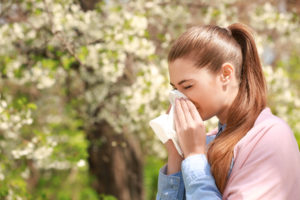Allergies and Golf Don’t Mix Well…
Coughing, sneezing, runny noses, and all the works. Allergies and golf…what a fun mix!
If you love golf but suffer from seasonal allergies, the allergy triggers hiding in the grass and trees can be more challenging than the sand traps and water hazards you may face.
The American College of Allergy, Asthma & Immunology has it that roughly 50 million Americans suffer from hay fever (also known as allergic rhinitis) which means a lot weepy, itchy people on the golf course.
Dr. Suppiah told Golf Channel’s Morning Drive last summer that in addition to the common symptoms, allergies also suck energy from golfers.
“When your allergies are bad,” he said, “your immune system… is a bit like national security, it’s on red alert, on high alert, and it’s on 24-7, even when you sleep. That saps a lot of the energy in your body.”
There are a number of over-the-counter medications available to address the common symptoms. If those don’t work, a more substantial form of immunotherapy treatment might be needed, such as an allergy shot or an under-the-tongue tablet, both of which could be prescribed by your health care provider.

Even PGA stars like Tiger Woods and Annika Sorenstam struggle with allergy symptoms on the golf course. For allergy sufferers, the good news is that there are simple ways to help reduce exposure to these allergens, as well as several effective treatment options.
Otherwise, here are a few tips for golfers who deal with allergies:
Carry a towel to wipe down balls and clubs between shots.
Wiping the ball and clubs between shots will limit the spread of pollen on equipment.
Avoid golfing when pollen counts are highest.
Dry, breezy days may seem fine for a round of golf but these weather conditions also cause high pollen counts. Instead of teeing off bright and early, consider an afternoon or twilight round because pollen counts are highest from 5 a.m. to 10 a.m.
Wear sunglasses to keep pollen from getting in your eyes.
You’re not going to be able to keep your eyes on the ball if your eyes become swollen and filled with tears. Check out these awesome women’s golf sunglasses.
Visit your doctor before allergy symptoms start.
If you suffer from nasal-congestion, your doctor might prescribe you nasal-inhaled steroids, which is the recommended treatment option. You may also consider using eyedrops, such as Patanol, Optivar, and Pataday, which can help soothe the itchy, watery eyes that come with allergies.
Looking for a way to skip the doc? In recent years, two oral antihistamines that were previously available only by prescription became available over the counter. That means you can pick up Claritin (loratadine) or Zyrtec (cetirizine) without a visit to a doctor.
Change clothes after the round and keep your golf gear in a zipped bag.
Pollen can collect on clothes, especially if you spent a lot of time searching for your ball in high grass. Take all of it straight to the wash when you get home to avoid bringing allergens into your home.
Shower after your round.
Be sure to wash or rinse your hair to remove allergens that might be on your body. Any of these can affect concentration—adding strokes to a score—and more importantly, decreasing enjoyment of the golf round. Make sure you prepare for your allergies whether it’s through medicine, wearing sunglasses, changing your clothes, or all of the above.
Allergies and golf don’t mix well together, but don’t let it ruin your golf game!



